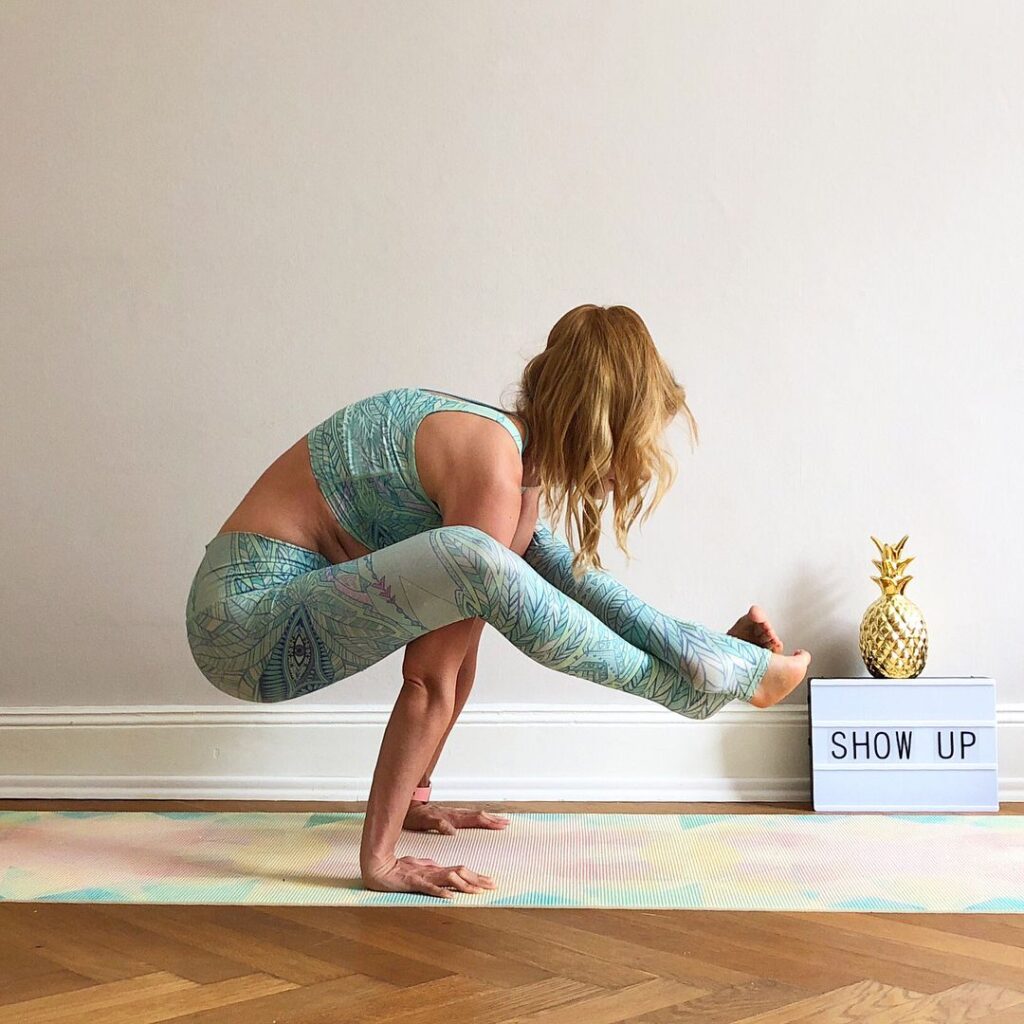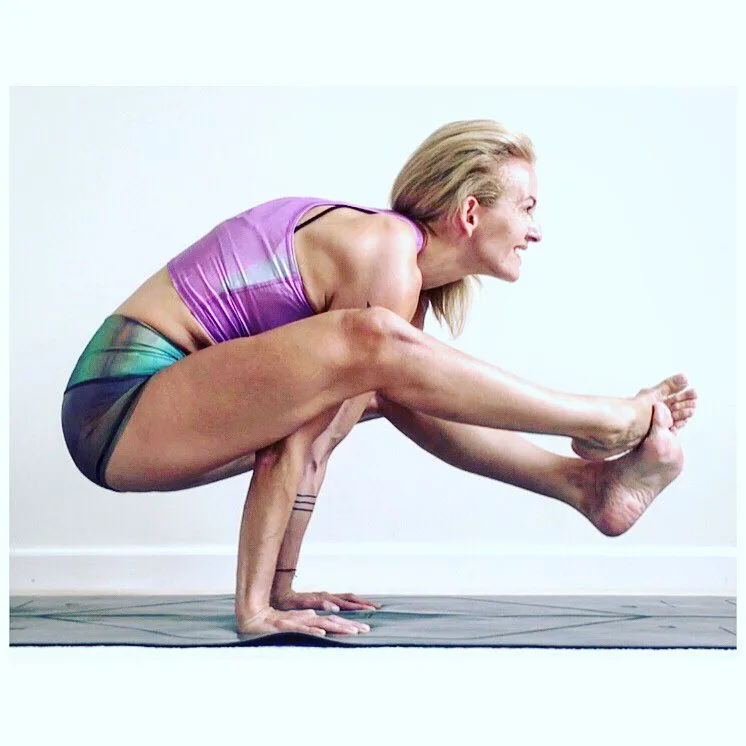Bhujapidasana (Shoulder Press Pose) is a challenging posture for strength and balance, it builds strength in arms, wrists, elbows, shoulders, upper back, chest, core, hips and also develops good posture.
Bhujapidasana (Shoulder Pressing Pose) is the first arm balance of the Ashtanga Yoga primary series. Practicing will develop and tone the small muscles of the arms, which do not require any special equipment or gym. The pose combines the core strength developed in external hip rotation and vinyasa movements in a challenging yet accessible way.
Since it is a challenging yoga pose, it requires balance, flexibility and strength in the hands, shoulders and wrists to wrap the feet on the palms around the shoulders or upper arms.
If you’ve never tried arm balancing before, it will feel like a magical lift off the ground and test your limits on what you think is possible.
Start with a relaxed attitude and be prepared to put in the work that takes a long time. Both the asana and traditional are seeking entry and exit. Full movement requires mental and physical stamina. Don’t give up, even if it seems absolutely impossible at first. Dedication to the entire learning and evolutionary process.
Information
| Known as: | Bhujapidasana, Shoulder Press Pose, Shoulder Pressing Posture |
| Sanskrit name: | भुजपीडासन |
| IAST: | Bhujapīḍāsana |
| Pronunciation: | buj-uh-peed-AHS-uh-nuh |
| Level: | Advanced |
| Type: | Arm balancing, Forward-Bend Pose |
| Total time: | 30 seconds |
| Drishti: | Nasagrai or Nasagre (nose); Padayoragrai or Padayoragre (toes/feet) |
| Chakra: | Manipura Chakra |
| Focus: | Arms, wrists, elbows, shoulder, upper back, chest, core |
| Indications: | Internal organs, pancreas, constipation, indigestion, balance |
| Preparatory poses: | Eagle Pose, Garland Pose, Crane Pose, Crow Pose, Bound Angle Pose |
| Follow-up poses: | Standing Forward Bend Pose, Downward-Facing Dog Pose, Upward-Facing Dog Pose |
| Contraindications: | Shoulder, wrist, elbow, lower back injury |
Meaning + Origin
The Bhujapidasana is derived from the Sanskrit name, which is made up of three words — Bhuja + Pida + Asana:
- “Bhuja” = “arm or shoulder”
- “Pida” = “pain or pressure”
- “Asana” = “pose or posture”
In this posture, the body is balanced on the hands by resting the back of the knees on the shoulders, hence the name.
A simple explanation of this is that the legs wrapped around the hands represent a complex situation in life in which ordinary people often lose them. Bhujapidasana (Shoulder Pressing Posture) mimics the similar positioning of the limbs, which when practiced regularly finds a way through balance.
So, Bhujapidasana is meant to bring the off-track live in a manner or manner with which one establishes oneself while undergoing strenuous physical exercises. It empowers the inner being to attain highness, strength and stability in life.
Benefits of Bhujapidasana (Shoulder Press Pose)
Traditionally, Bhujapidasana (Shoulder Pressing Posture) is believed to activate the third, or Manipura chakra. This Chakra is the body’s energy and vitality center, including inner strength, confidence and courage. It is believed that activating the Manipura Chakra through Bhujapidasana (Shoulder Press Pose) removes fear and insecurities.
The arms and wrists are strengthened by the practice of Bhujapidasana (Shoulder Press Pose), just as the abdominal muscles are strengthened due to the contraction of the abdomen. The body will feel lighter. Practicing this yoga pose will develop and tone the small muscles of the arms, which do not require any special equipment or gym. Different parts of the body supply the weight and counterweight. Only will power is needed.
However, the physical and mental benefits of Bhujapidasana (Shoulder Pressure Pose) are listed below:
- Physical Benefits:
- Strengthens wrists, arms, hands, chest, shoulders and upper back
- Helps to tone the internal organs
- Builds core strength and opens up the hips and pelvis
- Increased working memory and cognitive ability along with faster information processing
- Improve blood circulation
- Balances the body’s energy regulates the function of the digestive organs and pancreas
- Mental Benefits:
Bhujapidasana (Shoulder Press Pose) Practice Guide
Bhujapidasana has many similar joint actions to those found in Tittibhasana (Firefly pose), except here the ankles are crossed, and the knees are flexed. As with Tittibhasana (Firefly pose), Kurmasana (Tortoise Pose) can be used to prepare the hips and back for the pose.
Ideally, your legs are as high up as possible on your arms, with the weight of the body balanced over your hands. A great deal of flexibility must be attained in your lower back and gluteals to perform this posture. There should also be sufficient external rotation of your hips (meaning length of the internal rotators).
Press up into the pose by straightening your elbows while squeezing your legs around the arms. Your thighs form a bandha, or a “lock,” where they join with your arms. The contact point where your ankles cross forms another bandha. Trying to pull your feet apart augments this lock, strengthening the abductors of your hips. Alternatively, you can bend your knees and use the thighs and calves to squeeze your arms (while at the same time attempting to straighten your elbows).
Step-by-step Bhujapidasana (Shoulder Press Pose)

Gain flexibility in your hips by stretching the internal rotators with Cradle Stretch (Hindolasana). Use a facilitated stretch to make this more efficient (protecting the knees at all times). Lengthen and prepare the lower back muscles with poses like Prasarita Padottanasana (Wide Stance Forward Bend Pose), Kurmasana (Turtle Pose), and Uttanasana (Intense forward-bending pose). Strengthen the wrists and arms with Chaturanga Dandasana (Four-Limbed Staff pose) and Full Arm Balance (Adho Mukha Vrksasana).
Instructions
- Stand in Tadasana (Mountain Pose) and spread your legs until the feet are about two feet apart.
- Lean forward and bend your knees. Place your palms on the floor at a distance of about one and a half feet between your feet.
- Rest the back of your thighs on the back of your upper arms. Rest your thighs between your shoulders and elbows in the middle of your upper arms.
- Keeping your thighs in this position, initially lift your heels off the floor.
- Exhale, slowly lift your toes off the floor one by one, balancing on the hands and then interlocking the feet at your ankles.
- In the beginning, your feet will slide down and it will be difficult to balance. To secure balance, try to keep the back of your thighs on your upper arms as high as you can. Your arms will be slightly bent at your elbows. Try to extend your arms as far as possible and raise your head.
- Remain in this position with normal breathing until your wrists can bear the weight of your body. Then release your feet while taking your feet back one by one and then rest them on the floor. Raise your hands off the floor and stand in Tadasana (Mountain Pose).
- Repeat the process by changing the position of your fused ankles. If, previously, you placed the right foot on top of the left foot at the ankle, repeat the process by placing the left foot on top of the right foot at the ankle.
Step-by-step Anatomy Engaging Techniques
Step-1
Flex your trunk and hips by contracting your psoas and its synergists (pectineus, adductors longus and brevis, and sartorius). Engage your rectus abdominis by gently squeezing your abdominal muscles to further stabilize the pose.
Step-2
Hook one foot over your other. Then lock your legs by activating your tibialis anterior muscles (pull the tops of your feet toward the shins). Lift your ankles by tilting the outer edges of your feet upward. Your peroneus longus and brevis make up this action. Then lock in at your ankles with the variations explained in Step-4 and Step-5.
Step-3
- Press the mound at the base of your index finger into the mat by pronating your forearms with your pronator teres and your quadratus. To straighten your elbows, lift your body up by engaging your triceps. Straightening your elbows creates an external resistance against your thighs, making one half lock, the other half created by your legs. Then use your anterior and lateral deltoids to drive your shoulders forward (as if you were lifting your arms overhead).
- Contract your pectoralis major in front of your chest to add and stabilize the lift. Your serratus anterior will automatically activate and abduct your scapulae away from the midline of your back, keeping your shoulder blades in place. The indication for this is to visualize your hands pressing against a wall while visualizing this muscle engage.
- Finally, externally rotate your shoulders by contracting your infraspinatus and teres minor muscles, as well as your posterior deltoids. This action combines with pronation of your forearms under the arms and through your elbows to tighten the ligaments around your elbow joints (ligamentotaxis). This further stabilizes your arms in the posture.
Step-4
Try to straighten your knees by contracting your quadriceps. This is a variation that can be used to create a bandha where your hands and legs meet. Your tensor fascia lata contributes to this action, in addition to coordinating your psoas in flexing your hips. This internally rotates your hips, counteracting the pull of the stretching gluteus maximus. Visualize your gluteus minimus contraction to assist your tensor fascia lata.
Step-5
Try another variation of Bhujapidasana (Shoulder Press Pose), where you engage your hamstrings and bend your knees. This squeezes your arms between your calves and thighs. At the same time, straighten your elbows and notice how your arms and legs form a lock, or bandha.
Precautions and contraindications
- Practitioners should avoid direct forward bend into the Bhujapidasana (Shoulder Press Pose) if you have a condition of the lower back. A slow and steady forward roll might prevent the chances of injuries concerning this practice.
- To adjust your thighs on the region behind your elbow, you should focus on firming your palms in order to keep hands straight and stabilized. Because shifting weight lays heavy stress of body weight on hands, and lethargy at that time could be injurious.
- Practitioners should not drop their body backward while in the final position of Bhujapidasana (Shoulder Press Pose). It could result in injuries to your head or spine. Keep the body a little forward and engage the shoulder blade to find the balance in your torso.
- Pregnant women should avoid doing this yoga asana because the upper thigh might obstruct the stomach. However, menstruating women also avoid practicing this yoga pose as long as the cycle persists.
- Individuals who have undergone abdominal surgery should refrain from doing Bhujapidasana (Shoulder Press Pose) as it might be disturbing to the incision which is being cured or is yet to be.
- Individuals with elbow, wrist, lower back or shoulder injuries should avoid practicing shoulder presses, it might have worsened your previous condition if you ignored.
- Individual with the condition of cervical spondylitis and high blood pressure should avoid practicing this yoga asana. Balancing could harm the vertebrae, and challenging levels might raise blood pressure.















